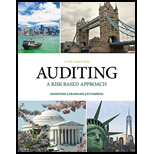
Introduction:
It is about the degree of risk involved in the prudence shown the auditor while ascertaining the sufficiency and appropriateness of audit evidence, which might result into material statement if prudence is not displayed. It also wants us to explain that if there is a high risk factor decision and low risk decision is to be taken, how sufficiency and appropriateness goes in contrast and the materiality aspect is changed.
To explain:
It is about the importance of sufficiency and appropriateness factor of auditevidence, which may result into material misstatement related with that client. It is also about the contrast factor of difference in sufficiency and appropriateness, if it is the case of a high risk decision or a low risk decision.
Want to see the full answer?
Check out a sample textbook solution
Chapter 6 Solutions
Auditing: A Risk Based-Approach (MindTap Course List)
 Auditing: A Risk Based-Approach (MindTap Course L...AccountingISBN:9781337619455Author:Karla M Johnstone, Audrey A. Gramling, Larry E. RittenbergPublisher:Cengage Learning
Auditing: A Risk Based-Approach (MindTap Course L...AccountingISBN:9781337619455Author:Karla M Johnstone, Audrey A. Gramling, Larry E. RittenbergPublisher:Cengage Learning Auditing: A Risk Based-Approach to Conducting a Q...AccountingISBN:9781305080577Author:Karla M Johnstone, Audrey A. Gramling, Larry E. RittenbergPublisher:South-Western College Pub
Auditing: A Risk Based-Approach to Conducting a Q...AccountingISBN:9781305080577Author:Karla M Johnstone, Audrey A. Gramling, Larry E. RittenbergPublisher:South-Western College Pub Intermediate Financial Management (MindTap Course...FinanceISBN:9781337395083Author:Eugene F. Brigham, Phillip R. DavesPublisher:Cengage Learning
Intermediate Financial Management (MindTap Course...FinanceISBN:9781337395083Author:Eugene F. Brigham, Phillip R. DavesPublisher:Cengage Learning


